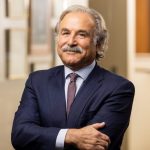Bain joined Long & Foster Cos. in 2010 as president of its insurance and home warranty businesses. Berkshire Hathaway affiliate HomeServices of America acquired Long & Foster in 2017, and in 2018, Bain took on oversight of Long & Foster Property Management and Long & Foster Rental Service Center. Bain rebranded the property management business as HomeServices Property Management two years ago, and in early 2022, launched Insight Home Inspections. In March 2023, he became Long & Foster’s president and CEO.
Bain and other real estate executives have lately been dealing with class-action lawsuits that allege the real estate industry has colluded to keep homebuyers’ agents and brokers’ commissions high. Bain, in an interview with The Georgetowner on March 13, said allegations of “collusions and conspiracy” were untrue. “We are aggressively defending our position.” Two days after the interview was published, the National Association of Realtors reached a $418 million settlement in multiple federal class-action suits, although it still must be approved by the court and possibly the Justice Department.
Founded in 1968, Long & Foster has more than 200 offices and 9,000 real estate agents.

































